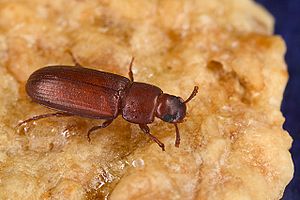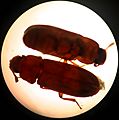Red flour beetle facts for kids
Quick facts for kids Red flour beetle |
|
|---|---|
 |
|
| Scientific classification | |
| Synonyms | |
|
Numerous, see text |
The red flour beetle (Tribolium castaneum) is a type of beetle that belongs to the darkling beetle family. These tiny beetles are known around the world as a pest because they often get into stored foods, especially grains. Scientists also study them as a model organism to learn about animal behavior and food safety.
Contents
Description
Adult red flour beetles are quite small, usually about 3 to 4 millimeters long (which is about 1/8 of an inch). They are typically a solid color, like rust, brown, or black.
Ecology
Red flour beetles like to eat stored grains and other food items. This includes flour, cereals, pasta, biscuits, beans, and nuts. They can cause a lot of damage and make these foods unusable. The United Nations has said that the red flour beetle and its close relative, the confused flour beetle, are "the two most common pests of all plant foods stored around the world."
Distribution and habitat
Red flour beetles originally came from areas around India and Australia. They don't do as well living outdoors as their close cousin, the confused flour beetle. Because of this, you'll find them more often in warmer, southern parts of the world. However, both types of beetles can be found worldwide in places that are heated, like homes and warehouses.
Adult red flour beetles can live for a long time, sometimes more than three years! Even though people used to think these beetles didn't move much, studies have shown they can actually fly long distances to find new places to live.
How Red Flour Beetles Reproduce
Female red flour beetles often mate with many different males. This behavior helps them make sure they have enough genetic material to produce many healthy babies. It's especially important because some male beetles might have already mated many times and have less genetic material to share.
Why Mating with Many Partners Helps
Mating with several males can help female beetles get enough genetic material for successful reproduction. In nature, male beetles might have a low amount of genetic material if they've mated often. So, a female might need to mate with a few males to ensure she can produce offspring.
Mating with many partners can also increase the genetic diversity of the baby beetles. This means the babies will have a wider mix of traits, which can be helpful. If the environment suddenly changes, having different traits might help some of the beetles survive and reproduce better.
Challenges of Mating with Many Partners
Competition Among Males
The number of beetles and available food can affect how much each beetle mates. If there are too many beetles in one place with limited food, fewer babies might survive. This means male beetles often compete to be the last one to mate with a female. Being the last one increases their chances of being the parent of the babies. In places with little food, males might even eat other male beetles, which can reduce the total number of babies produced.
Offspring Health
Sometimes, mating with many partners doesn't always lead to the healthiest babies. Male red flour beetles attract females using special scents called pheromones. The ability to make these strong scents is passed down through genes. However, just because a male is good at attracting females doesn't mean his babies will be the healthiest. The babies' health isn't always linked to how good their father was at attracting partners.
Different Mating Choices
Female beetles from different parts of the world, with different genetic backgrounds, can show different mating behaviors. Some females might avoid mating with many partners, while others do it a lot. This shows that mating with many partners can be good for some groups of beetles but not for others.
Female beetles can also choose which male's genetic material they use to make babies. They have special storage areas for genetic material from different males. Later, they can decide which one to use for reproduction.
Male beetles are also picky about their partners. They prefer to mate with females that are mature and haven't mated before. If a male mates with a female who hasn't mated yet, his genetic material has a very high chance of being used to make babies. Males can tell the difference between females who have mated and those who haven't by their scent. Males with more scent receptors are better at choosing the best females, which helps them have more offspring. Also, males that leave stronger scents can stop other males from trying to mate with a female who has already been fertilized.
Mating in Populations with Low Genetic Variety
Both male and female red flour beetles can mate with many partners. This is especially common in groups of beetles that don't have much genetic diversity. When there's low genetic diversity, mating with many partners helps beetles avoid reproducing with close relatives, which can cause problems. The more partners a beetle has, the better the chance that at least one partner is not a close relative. This helps increase the genetic variety in the baby beetles and reduces problems from mating with relatives.
Even though some studies show that related beetles can still have babies, they usually produce far fewer offspring than beetles who are not related. This lower number of babies is a type of inbreeding depression, meaning problems caused by mating with close relatives.
Male red flour beetles can recognize their relatives, but females cannot. This means females might mate with any male in their group. Females also store genetic material after mating. The first male to mate usually contributes more genetic material to be stored. However, the last male to mate can often remove previously stored genetic material, giving his own a better chance to make babies.
Polygyny and Reproduction Success
Male red flour beetles also mate with many partners. This behavior helps them avoid problems from inbreeding, especially when other males are competing. Males who are not closely related to their partners have a higher chance of successful reproduction when they compete with related males to fertilize the same female.
In beetles that mate with many partners, the male who mates last with a female often has the highest chance of being the parent of the babies. This competition among males to be the last one to mate helps them contribute more to the next generation.
As a Model Organism
The red flour beetle is very important in science as a "model organism." This means scientists study it to understand how other insects develop and how their genes work. In 2008, scientists mapped out all the genes of the red flour beetle. They compared these genes to those of other insects, like the fruit fly (Drosophila).
The red flour beetle and the fruit fly share many genes, but they also have differences. For example, in fruit flies, a gene called bicoid helps control how the front and back parts of the body develop. But red flour beetles don't have this gene. Instead, other genes like orthodenticle and hunchback do a similar job in the red flour beetle.
Red flour beetles are also great for experiments using a technique called RNAi. RNAi is a way to turn off specific genes to see what they do. RNAi works even better in red flour beetles than in fruit flies, making them perfect for these kinds of studies.
Scientists can also use CRISPR technology to study red flour beetles. CRISPR is a tool that allows scientists to make very precise changes to genes. For example, researchers used CRISPR to turn off a gene called E-cadherin in red flour beetles. This gene is important for how cells stick together. When the gene was turned off, the beetles had problems developing their backs. This shows that CRISPR is a useful tool for studying the red flour beetle as a model insect.
Synonyms
Tribolium castaneum has been known by several other scientific names over time. Some of these are:
- Colydium castaneum Herbst, 1787
- Margus castaneus Dejean, 1833
- Phaleria castanca Gyllenhal, 1810
- Stene ferruginea Westwood, 1839
- Tenebrio castaneus Schönherr, 1806
- Tribolium ferrugineum , Wollaston, 1854
- Tribolium navale (Fabricius, 1775)
- Uloma ferruginea Dejean, 1821
Some names were thought to be synonyms but actually belong to other species.
Images for kids





